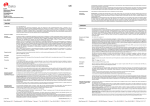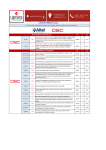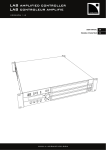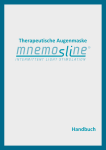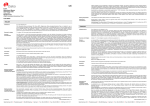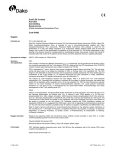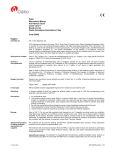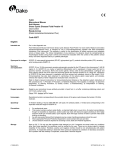Download (Dako Autostainer/Autostainer Plus) Code IS653
Transcript
into the Autostainer Link software. Please refer to the proper Autostainer Link User Guide for detailed instructions on loading slides and reagents. If the protocols are not available on the used Autostainer platform, please contact Dako Technical Services. All incubation steps should be performed at room temperature. Optimal conditions may vary depending on specimen and preparation methods, and should be determined by each individual laboratory. If the evaluating pathologist should desire a different staining intensity, a Dako Application Specialist/Technical Service Specialist can be contacted for information on reprogramming of the protocol. Verify that the performance of the adjusted protocol is still valid by evaluating that the staining pattern is identical to the staining pattern described in “Performance characteristics”. FLEX Monoclonal Mouse Anti-Human ZAP-70 Clone 2F3.2 Ready-to-Use (Dako Autostainer/Autostainer Plus) Counterstaining in hematoxylin is recommended using EnVision FLEX Hematoxylin, (Link) (Code K8008). Non-aqueous, permanent mounting medium is recommended. Positive and negative controls should be run simultaneously using the same protocol as the patient specimens. The positive control tissue should include tonsil and the cells/structures should display reaction patterns as described for this tissue in “Performance characteristics” in all positive specimens. The recommended negative control reagent is FLEX Negative Control, Mouse, (Link) (Code IR750). Code IS653 Staining interpretation Cells labeled by the antibody display cytoplasmic and nuclear staining. Performance characteristics Normal tissues: The antibody labels T cells in lymphoid tissues such as tonsil and gut-associated lymphoid tissue, as well as in other tested tissues, including colon, kidney, liver, pancreas and prostate. Occasionally, the antibody labels cytoplasmic vesicles in the proximal tubuli of the kidney. The cytoplasm of nerve cells is occasional labeled in cerebellum and in the peripheral nerve cells in colon. Cytoplasmic vesicles are also occasional labeled in hepatocytes and bile duct epithelial cells of the liver, and in pancreatic islets and ducts. In addition to T cells, the antibody prominently labels the epithelial cell cytoplasma of distale tubuli and collecting ducts in kidney. Isolated T-cells in the germinal centers in the tonsil show a moderate to strong staining reaction, whereas crowded T-cells in the T-zone show a weak to moderate staining reaction. Abnormal tissues: In B-cell neoplasms, the antibody labeled neoplastic B cells in 34/52 CLL, 9/29 Burkitt’s lymphomas, 2/7 lymphoblastic lymphomas, 3/36 mantle cell lymphomas, 1/23 marginal zone lymphomas, and 1/45 diffuse large B-cell lymphomas. No B cells were labeled in 19 cases of follicular lymphomas and 14 cases of Hodgkin’s lymphomas (1). In another study, the antibody labeled neoplastic B cells in a subset of CLLs in both bone marrow biopsies, aspirate sections and paraffin cell pellets of peripheral blood mononuclear cells (2). In a study of various hematopoietic malignant neoplasms, the antibody labeled the neoplastic T cells in 45/62 T-cell malignant neoplasms but in 0/41 of acute myelogenous leukemia. Only in 2/136 Hodgkin’s lymphomas, the antibody labeled Hodgkin’s cells. Of the B-cell malignant neoplasms, the antibody labeled neoplastic B cells in 12/26 small lymphocytic lymphomas, 4/76 diffuse large B-cell lymphomas, 1/6 mantle cell lymphomas, 7/24 B-cell acute lymphoblastic leukemias/lymphoblastic lymphomas. The antibody did not label neoplastic B cells in 22 cases of marginal zone lymphomas, 40 cases of follicular lymphomas, 6 cases of Burkitt’s lymphomas nor in 5 cases of lymphoplasmacytic lymphomas (6). In all mentioned studies, the antibody labeled normal T cells (1, 2, 6). ENGLISH Intended use For in vitro diagnostic use. FLEX Monoclonal Mouse Anti-Human ZAP-70, Clone 2F3.2, Ready-to-Use, (Dako Autostainer/Autostainer Plus), is intended for use in immunohistochemistry together with Dako Autostainer/Autostainer Plus instruments. This antibody is useful for identification of ZAP-70 in a subset of chronic lymphocytic leukemias (1, 2). The clinical interpretation of any staining or its absence should be complemented by morphological studies using proper controls and should be evaluated within the context of the patient's clinical history and other diagnostic tests by a qualified pathologist. Summary and explanation ZAP-70 (ζ–associated protein of 70 kDa) is a tyrosine kinase of the Syk family that plays a critical role in triggering the signaling cascade in response to T-cell receptor stimulation (1). It is primarily expressed in T cells and natural killer (NK) cells (1-6), but is also detectable in mast cells and basophils (2). ZAP-70 is also expressed in normal pro/pre B cells but not in normal mature B cells (4). ZAP-70 is expressed in B cells in a subset of chronic lymphocytic leukemias (CLL) closely associated with an unmutated configuration of the immunoglobulin heavy-chain variable region (IgVH) genes (1-3, 5, 6). The precise functional significance of ZAP-70 in this subset of CLL B cells is unknown. Some data indicates that expression of ZAP-70 in CLL allows more effective IgM signaling in CLL B cells, which could explain the disease progress (5). Also, some other B-cell neoplasms (1, 6) and T-cell neoplasms express ZAP-70 (6). Refer to Dako’s General Instructions for Immunohistochemical Staining or the detection system instructions of IHC procedures for: 1) Principle of Procedure, 2) Materials Required, Not Supplied, 3) Storage, 4) Specimen Preparation, 5) Staining Procedure, 6) Quality Control, 7) Troubleshooting, 8) Interpretation of Staining, 9) General Limitations. Reagent provided Ready-to-use monoclonal mouse antibody provided in liquid form in a buffer containing stabilizing protein and 0.015 mol/L sodium azide. Clone: 2F3.2. Isotype: IgG2a, kappa. Immunogen Recombinant ZAP-70 protein including residues 1-254 and encompassing SH2 domains of human ZAP-70 (7). Specificity In Western blotting of whole cell lysates of normal peripheral blood mononuclear cells, the antibody labels a band corresponding to ZAP-70 (2). In Western blotting of whole cell lysates of CD19-positive purified leukemia cells from patients with Ig-unmutated and Ig-mutated CLL, the antibody labels a band corresponding to ZAP-70 in the Ig-unmutated CLL samples, whereas no band is observed in the Ig-mutated CLL samples (2). In Western blotting of cell lysates of Jurkat cells (T-lymphoblastic cell line), the antibody labels a band of 70 kDa protein (6). In Western blotting of cell lysates of A431 cells (carcinoma cell line), no band is observed (6). Precautions 1. For professional users. 2. This product contains sodium azide (NaN3), a chemical highly toxic in pure form. At product concentrations, though not classified as hazardous, sodium azide may react with lead and copper plumbing to form highly explosive build-ups of metal azides. Upon disposal, flush with large volumes of water to prevent metal azide build-up in plumbing. 3. As with any product derived from biological sources, proper handling procedures should be used. 4. Wear appropriate Personal Protective Equipment to avoid contact with eyes and skin. 5. Unused solution should be disposed of according to local, State and Federal regulations. Store at 2-8 °C. Do not use after expiration date sta mped on vial. If reagents are stored under any conditions other than those specified, the conditions must be verified by the user. There are no obvious signs to indicate instability of this product. Therefore, positive and negative controls should be run simultaneously with patient specimens. If unexpected staining is observed which cannot be explained by variations in laboratory procedures and a problem with the antibody is suspected, contact Dako Technical Support. Storage Specimen preparation including materials required but not supplied Staining procedure including materials required but not supplied The antibody can be used for labeling formalin-fixed, paraffin-embedded tissue sections. Tissue specimens should be cut into sections of approximately 4 µm. Pre-treatment with heat-induced epitope retrieval (HIER) is required using Dako PT Link (Code PT100/PT101). For details, please refer to the PT Link User Guide. Optimal results are obtained by pretreating tissues using EnVision FLEX Target Retrieval Solution, High pH (50x) (Code K8010/K8004). Paraffin-embedded sections: Pre-treatment of formalin-fixed, paraffin-embedded tissue sections is recommended using the 3-in-1 specimen preparation procedure for Dako PT Link. Follow the pre-treatment procedure outlined in the package insert for EnVision FLEX Target Retrieval Solution, High pH (50x) (Code K8010/K8004). Note: After staining the sections must be dehydrated, cleared and mounted using permanent mounting medium. Deparaffinized sections: Pre-treatment of deparaffinized formalin-fixed, paraffin-embedded tissue sections is recommended using Dako PT Link and following the same procedure as described for paraffin-embedded sections. After staining the slides should be mounted using aqueous or permanent mounting medium. The tissue sections should not dry out during the treatment or during the following immunohistochemical staining procedure. For greater adherence of tissue sections to glass slides, the use of FLEX IHC Microscope Slides (Code K8020) is recommended. FRANÇAIS Utilisation prévu Pour utilisation lors d’un diagnostic in vitro. FLEX Monoclonal Mouse Anti-Human ZAP-70, Clone 2F3.2, Ready-to-Use, (Dako Autostainer/Autostainer Plus), est destiné à une utilisation en immunohistochimie avec les instruments Dako Autostainer/Autostainer Plus. L’anticorps est utile pour l’identification du ZAP-70 dans un sous-ensemble de leucémies lymphocytaires chroniques (1, 2). L’interprétation clinique de toute coloration ou son absence doit être complétée par des études morphologiques en utilisant des contrôles appropriés et doit être évaluée en fonction des antécédents cliniques du patient et d’autres tests diagnostiques par un pathologiste qualifié. Résumé et explication La ZAP-70 (protéine de 70 kDa, associée à la séquence ζ) est une tyrosine kinase de la famille Syk, jouant un rôle essentiel dans le déclenchement des signaux en cascade en réponse à la stimulation des récepteurs des lymphocytes T (1). Elle est exprimée principalement dans les lymphocytes T et les cellules tueuses naturelles (NK) (1-6), mais est également détectable dans les mastocytes et les basophiles (2). La ZAP-70 s’exprime également dans les progéniteurs/précurseurs des lymphocytes B sains mais pas dans les lymphocytes B sains matures (4). La ZAP-70 est exprimée dans les lymphocytes B d’un sous-ensemble de leucémies lymphocytaires chroniques (CLL) fortement associées à une configuration non mutée des gènes de la séquence variable (IgVH) de la chaîne lourde d’immunoglobuline (1–3, 5, 6). La signification fonctionnelle précise de la ZAP-70 dans ce sous-ensemble de CLL à lymphocytes B est inconnue. Certaines données indiquent que l’expression de la ZAP-70 dans les CLL permet un signal IgM plus efficace dans les CLL à lymphocytes B, ce qui pourrait expliquer la progression de la maladie (5). Certains autres néoplasmes à lymphocytes B (1, 6) et à lymphocytes T expriment également la ZAP-70 (6). Se référer aux Instructions générales de coloration immunohistochimique de Dako ou aux instructions du système de détection relatives aux procédures IHC pour plus d’informations concernant les points suivants : 1) Principe de procédure, 2) Matériels requis mais non fournis, 3) Conservation, 4) Préparation des échantillons, 5) Procédure de coloration, 6) Contrôle qualité, 7) Dépannage, 8) Interprétation de la coloration, 9) Limites générales. Réactifs fournis Anticorps monoclonal de souris prêt à l’emploi fourni sous forme liquide dans un tampon contenant une protéine stabilisante et 0,015 mol/L d’azide de sodium. Clone : 2F3.2. Isotype : IgG2a, kappa. Immunogène Protéine recombinante ZAP-70 comprenant des résidus 1–254 et englobant les domaines SH2 de la ZAP-70 humaine (7). Spécificité Par Western blot de lysats totaux de mononucléaires sains du sang périphérique, l’anticorps marque une bande correspondant à la ZAP-70 (2). Par Western blot de lysats totaux de cellules leucémiques purifiées positives au CD-19 provenant de patients atteints de CLL à Ig non mutée et Ig mutée, l’anticorps marque une bande correspondant à la ZAP-70 dans les échantillons de CLL à Ig non mutée, alors qu’aucune bande n’est observée dans les échantillons de CLL à Ig mutée (2) Par Western blot de lysats de cellules de Jurkat (lignée cellulaire lymphoblastique T), l’anticorps marque une bande de protéine de 70 kDa (6). Par Western blot de lysats de cellules A431 (lignée cellulaire de carcinome), aucune bande n’a été observée (6). Précautions 1. Pour utilisateurs professionnels. 2. Ce produit contient de l’azide de sodium (NaN3), produit chimique hautement toxique dans sa forme pure. Aux concentrations du produit, bien que non classé comme dangereux, l’azide de sodium peut réagir avec le cuivre et le plomb des canalisations et former des accumulations d’azides métalliques hautement explosifs. Lors de l’élimination, rincer abondamment à l’eau pour éviter toute accumulation d’azide métallique dans les canalisations. 3. Comme avec tout produit d’origine biologique, des procédures de manipulation appropriées doivent être respectées. 4. Porter un vêtement de protection approprié pour éviter le contact avec les yeux et la peau. 5. Les solutions non utilisées doivent être éliminées conformément aux réglementations locales et nationales. Conservation Conserver entre 2 et 8 C. Ne pas utiliser après la date de péremption indiquée sur le flacon. Si les réactifs sont conservés dans des conditions autres que celles indiquées, celles-ci doivent être validées par l’utilisateur. Il n’y a aucun signe évident indiquant l’instabilité de ce produit. Par conséquent, des contrôles positifs et négatifs doivent être testés en même temps que les échantillons de patient. Si une coloration inattendue est observée, qui ne peut être expliquée par un changement des procédures du laboratoire, et en cas de suspicion d’un problème lié à l’anticorps, contacter l’assistance technique de Dako. Préparation des échantillons y compris le matériel requis mais non fourni L’anticorps peut être utilisé pour le marquage des coupes de tissus inclus en paraffine et fixés au formol. L’épaisseur des coupes d’échantillons de tissu doit être d’environ 4 µm. Un prétraitement avec démasquage d’épitope induit par la chaleur (HIER) est nécessaire avec le Dako PT Link (Réf. PT100/PT101). Pour plus de détails, se référer au Guide d’utilisation du PT Link. Des résultats optimaux sont obtenus en prétraitant les tissus à l’aide de la EnVision FLEX Target Retrieval Solution, High pH (50x) (Réf. K8010/K8004). Coupes incluses en paraffine : le prétraitement des coupes tissulaires fixées au formol et incluses en paraffine est recommandé à l'aide de la procédure de préparation d'échantillon 3-en-un pour le Dako PT Link. Suivre la procédure de prétraitement indiquée dans la notice de la EnVision FLEX Target Retrieval Solution, High pH (50x) (Réf. K8010/K8004). Remarque : après coloration, les coupes doivent être déshydratées, lavées et montées à l’aide d’un milieu de montage permanent. Coupes déparaffinées : le prétraitement des coupes tissulaires déparaffinées, fixées au formol et incluses en paraffine, est recommandé à l’aide du Dako PT Link, en suivant la même procédure que pour les coupes incluses en paraffine. Après coloration, un montage aqueux ou permanent des lames est recommandé. Les coupes de tissus ne doivent pas sécher lors du traitement ni lors de la procédure de coloration immunohistochimique suivante. Pour une meilleure adhérence des coupes de tissus sur les lames de verre, il est recommandé d’utiliser des lames FLEX IHC Microscope Slides (Réf. K8020). The recommended visualization system is EnVision FLEX, High pH, (Dako Autostainer/Autostainer Plus) (Code K8010). The staining steps and incubation times are pre-programmed into the software of Dako Autostainer/Autostainer Plus instruments, using the following protocols: Template protocol: FLEXRTU2 (200 µL dispense volume) or FLEXRTU3 (300 µL dispense volume) Autoprogram: ZAP70 (without counterstaining) or ZAP70H (with counterstaining) The Auxiliary step should be set to “rinse buffer” in staining runs with ≤10 slides. For staining runs with >10 slides the Auxiliary step should be set to “none”. This ascertains comparable wash times. All incubation steps should be performed at room temperature. For details, please refer to the Operator’s Manual for the dedicated instrument. If the protocols are not available on the used Dako Autostainer instrument, please contact Dako Technical Services. Optimal conditions may vary depending on specimen and preparation methods, and should be determined by each individual laboratory. If the evaluating pathologist should desire a different staining intensity, a Dako Application Specialist/Technical Service Specialist can be contacted for information on reprogramming of the protocol. Verify that the performance of the adjusted protocol is still valid by evaluating that the staining pattern is identical to the staining pattern described in “Performance characteristics”. Counterstaining in hematoxylin is recommended using EnVision FLEX Hematoxylin, (Dako Autostainer/Autostainer Plus) (Code K8018). Non-aqueous, permanent mounting medium is recommended. Positive and negative controls should be run simultaneously using the same protocol as the patient specimens. The positive control tissue should include tonsil and the cells/structures should display reaction patterns as described for this tissue in “Performance characteristics” in all positive specimens. The recommended negative control reagent is FLEX Negative Control, Mouse, (Dako Autostainer/Autostainer Plus) (Code IS750). The recommended visualization system is EnVision FLEX, High pH, (Link) (Code K8000). The staining steps and incubation times are pre-programmed (117383-003) Dako Denmark A/S IS653/EFG/MNI/2009.12.04 p. 1/4 | Produktionsvej 42 | DK-2600 Glostrup | Denmark | Tel. +45 44 85 95 00 | Fax +45 44 85 95 95 | CVR No. 33 21 13 17 (117383-003) Dako Denmark A/S IS653/EFG/MNI/2009.12.04 p. 2/4 | Produktionsvej 42 | DK-2600 Glostrup | Denmark | Tel. +45 44 85 95 00 | Fax +45 44 85 95 95 | CVR No. 33 21 13 17 Procédure de coloration y compris le matériel requis mais non fourni Le système de visualisation recommandé est le EnVision FLEX, High pH, (Dako Autostainer/Autostainer Plus) (Code K8010). Les étapes de coloration et les temps d’incubation sont préprogrammés dans le logiciel des instruments Dako Autostainer/Autostainer Plus, à l’aide des protocoles suivants : Protocole modèle : FLEXRTU2 (volume d’application de 200 µL) ou FLEXRTU3 (volume d’application de 300 µL). Programme automatique : ZAP70 (sans contre-coloration) ou ZAP70H (avec contre-coloration). Vorbereitung der Probe und erforderliche, aber nicht mitgelieferte Materialien Der Antikörper eignet sich zur Markierung von formalinfixierten und paraffineingebetteten Gewebeschnitten. Gewebeproben sollten in Schnitte von ca. 4 µm Stärke geschnitten werden. Die Vorbehandlung durch hitzeinduzierte Epitopdemaskierung (HIER) mit Dako PT Link (Code-Nr. PT100/PT101) ist erforderlich. Weitere Informationen hierzu siehe PT Link-Benutzerhandbuch. Optimale Ergebnisse können durch Vorbehandlung der Gewebe mit EnVision FLEX Target Retrieval Solution, High pH (50x) (Code-Nr. K8010/K8004) erzielt werden. Paraffineingebettete Schnitte: Die Vorbehandlung der formalinfixierten, paraffineingebetteten Schnitte mit dem 3-in-1-Probenvorbereitungsverfahren für Dako PT Link wird empfohlen. Vorbehandlung gemäß der Beschreibung in der Packungsbeilage für EnVision FLEX Target Retrieval Solution, High pH (50x) (Code-Nr. K8010/K8004) durchführen. Hinweis: Nach dem Färben müssen die Schnitte dehydriert, geklärt und mit permanentem Einbettmedium auf den Objektträger aufgebracht werden. Entparaffinierte Schnitte: Eine Vorbehandlung der entparaffinierten, formalinfixierten, paraffineingebetteten Gewebeschnitte mit Dako PT Link nach demselben Verfahren, wie für die paraffineingebetteten Schnitte beschrieben, wird empfohlen. Die Objektträger nach dem Färben mit einem wässrigen oder permanenten Einbettmedium bedecken. Die Gewebeschnitte dürfen während der Behandlung oder des anschließenden immunhistochemischen Färbeverfahrens nicht austrocknen. Zur besseren Haftung der Gewebeschnitte an den Glasobjektträgern wird die Verwendung von FLEX IHC Microscope Slides (Code-Nr. K8020) empfohlen. Färbeverfahren und erforderliche, aber nicht mitgelieferte Materialien Als Visualisierungssystem wird EnVision FLEX, High pH, (Dako Autostainer/Autostainer Plus) (Code-Nr. K8010) empfohlen. Die Färbeschritte und Inkubationszeiten sind in der Software der Dako Autostainer/Autostainer Plus-Geräte mit den folgenden Protokollen vorprogrammiert: Matrix-Protokoll: FLEXRTU2 (200 µl Anwendungsvolumen) oder FLEXRTU3 (300 µl Anwendungsvolumen) Autoprogramm: ZAP70 (ohne Gegenfärbung) oder ZAP70H (mit Gegenfärbung) Bei Färbedurchläufen mit höchstens 10 Objektträgern sollte der Zusatz-Schritt auf „Pufferspülgang“ eingestellt werden. Für Färbedurchläufe mit mehr als 10 Objektträgern den Zusatz-Schritt auf „Keine“ einstellen. Dies gewährleistet vergleichbare Waschzeiten. Alle Inkubationsschritte sollten bei Raumtemperatur durchgeführt werden. Nähere Einzelheiten bitte dem Benutzerhandbuch für das jeweilige Gerät entnehmen. Wenn die Färbeprotokolle auf dem verwendeten Dako Autostainer-Gerät nicht verfügbar sind, bitte den Technischen Kundendienst von Dako verständigen. Optimale Bedingungen können je nach Probe und Präparationsverfahren unterschiedlich sein und sollten vom jeweiligen Labor selbst ermittelt werden. Falls der beurteilende Pathologe eine andere Färbungsintensität wünscht, kann ein Anwendungsspezialist oder Kundendiensttechniker von Dako bei der Neuprogrammierung des Protokolls helfen. Die Leistung des angepassten Protokolls muss verifiziert werden, indem gewährleistet wird, dass das Färbemuster mit dem unter „Leistungsmerkmale“ beschriebenen Färbemuster identisch ist. L’étape Auxiliary doit être réglée sur « rinse buffer » lors des cycles de coloration avec ≤10 lames. Pour les cycles de coloration de >10 lames, l’étape Auxiliary doit être réglée sur « none ». Cela confirme des temps de lavage comparables. Toutes les étapes d’incubation doivent être effectuées à température ambiante. Pour plus de détails, se référer au Manuel de l’opérateur spécifique à l'instrument. Si les protocoles ne sont pas disponibles sur l’instrument Dako Autostainer utilisé, contacter le service technique de Dako. Les conditions optimales peuvent varier en fonction du prélèvement et des méthodes de préparation, et doivent être déterminées par chaque laboratoire individuellement. Si le pathologiste qui réalise l’évaluation désire une intensité de coloration différente, un spécialiste d’application/spécialiste du service technique de Dako peut être contacté pour obtenir des informations sur la reprogrammation du protocole. Vérifier que l’exécution du protocole modifié est toujours valide en vérifiant que le schéma de coloration est identique au schéma de coloration décrit dans les « Caractéristiques de performance ». Il est recommandé d’effectuer une contre-coloration à l’aide d’hématoxyline EnVision FLEX Hematoxylin, (Dako Autostainer/Autostainer Plus) (Code K8018). L’utilisation d’un milieu de montage permanent non aqueux est recommandée. Des contrôles positifs et négatifs doivent être réalisés en même temps et avec le même protocole que les échantillons du patient. Le contrôle de tissu positif doit comprendre l’amygdale et les cellules/structures doivent présenter les schémas de réaction décrits pour ces tissus dans les « Caractéristiques de performance » pour tous les échantillons positifs. Le contrôle négatif recommandé est le FLEX Negative Control, Mouse, (Dako Autostainer/Autostainer Plus) (Code IS750). Interprétation de la coloration Les cellules marquées par l’anticorps présentent une coloration cytoplasmique et nucléaire. Caractéristiques de performance Tissus sains : l’anticorps marque les lymphocytes T dans les tissus lymphoïdes tels que l’amygdale et le tissu lymphoïde associé aux intestins ainsi que dans d’autres tissus testés, y compris le côlon, le rein, le foie, le pancréas et la prostate. Occasionnellement, l’anticorps marque les vésicules cytoplasmiques dans les tubules proximaux du rein. Le cytoplasme des cellules nerveuses est marqué occasionnellement dans le cervelet et dans les cellules nerveuses périphériques du côlon. Les vésicules cytoplasmiques sont également marquées occasionnellement dans les hépatocytes et les cellules épithéliales du canal biliaire du foie et dans les îlots et les conduits pancréatiques. En plus des lymphocytes T, l’anticorps marque fortement le cytoplasme des cellules épithéliales des tubules distaux et collecteurs du rein. Les lymphocytes T isolés des centres germinatifs des amygdales présentent une coloration modérée à forte, tandis que la coloration des amas de lymphocytes T dans la zone T était faible à modérée. Tissus tumoraux : Dans les néoplasmes à lymphocytes B, l’anticorps marque les lymphocytes B néoplasiques dans 34 cas sur 52 de CLL, 9 cas sur 29 de lymphomes de Burkitt, 2 cas sur 7 de lymphomes lymphoblastiques, 3 cas sur 36 de lymphomes à cellules du manteau, un cas sur 23 de lymphome de la zone marginale et un cas sur 45 de lymphomes diffus à grands lymphocytes. Aucun lymphocyte B n’était marqué dans 19 cas de lymphomes folliculaires et 14 cas de lymphomes de Hodgkin (1). Dans une autre étude, l’anticorps a marqué des lymphocytes B néoplasiques dans un sousensemble de CLL sur des biopsies de moelle osseuse, des biopsies par aspiration et des pellets cellulaires sur paraffine de mononucléaires de sang périphérique (2). Dans une étude portant sur divers néoplasmes hématopoïétiques malins, l’anticorps a marqué les lymphocytes T néoplasiques dans 45 cas sur 62 de néoplasme malin à lymphocytes T mais aucun cas sur 41 de leucémie myélogène aiguë. L’anticorps n’a marqué les cellules de Hodgkin que dans 2 cas sur 136 de lymphomes de Hodgkin. Pour les néoplasmes malins à lymphocytes B, l’anticorps a marqué les lymphocytes B néoplasiques dans 12 cas sur 26 de lymphome lymphocytaire, 4 cas sur 76 de lymphome diffus à grands lymphocytes B, un cas sur 6 de lymphome à cellules du manteau, 7 cas sur 24 de leucémie lymphoblastique aiguë à lymphocytes B/lymphomes lymphoblastiques. L’anticorps n’a pas marqué les lymphocytes B néoplasiques dans 22 cas de lymphome de la zone marginale, 40 cas de lymphome folliculaire, 6 cas de lymphome de Burkitt ni dans 5 cas de lymphome lymphoplasmocytaire (6). Dans toutes les études mentionnées, l’anticorps à marqué les lymphocytes T sains (1, 2, 6). Die Gegenfärbung in Hämatoxylin sollte mit EnVision FLEX Hematoxylin (Dako Autostainer/Autostainer Plus) (Code-Nr. K8018) ausgeführt werden. Empfohlen wird ein nichtwässriges, permanentes Fixiermittel. Positiv- und Negativkontrollen sollten zur gleichen Zeit und mit demselben Protokoll wie die Patientenproben getestet werden. Das positive Kontrollgewebe sollte Mandelgewebe enthalten und die Zellen/Strukturen müssen in allen positiven Proben die für dieses Gewebe unter „Leistungsmerkmale“ beschriebenen Reaktionsmuster aufweisen. Das empfohlene Negativ-Kontrollreagenz ist FLEX Negative Control, Mouse, (Dako Autostainer/Autostainer Plus) (Code-Nr. IS750). Auswertung der Färbung Mit diesem Antikörper markierte Zellen weisen ein zytoplasmatisches und nukleäres Färbemuster auf. Leistungsmerkmale Gesundes Gewebe: Der Antikörper markiert T-Zellen in lymphoiden Geweben, z. B. Mandelgewebe, darmassoziierte lymphoide Gewebe, sowie in anderen getesteten Geweben, einschließlich Dickdarm, Nieren, Leber, Pankreas und Prostata. Gelegentlich markiert der Antikörper zytoplasmische Vesikel in den proximalen Nierentubuli. Manchmal wird das Zytoplasma von Nervenzellen des Kleinhirns und von peripheren Nervenzellen des Darms markiert. Gelegentlich werden auch zytoplasmische Vesikel in Hepatozyten und Gallenwegsepithelzellen der Leber sowie Pankreasinseln und -gängen markiert. Zusätzlich zu T-Zellen markiert der Antikörper hauptsächlich das Epithelzellenzytoplasma der distalen Tubuli und Sammelgänge der Niere. Isolierte T-Zellen in den Keimzentren der Mandeln weisen eine mäßige bis starke Färbereaktion auf, während die eng gepackten T-Zellen in der T-Zone eine schwache bis mäßige Färbereaktion aufweisen. Pathologisches Gewebe: Bei B-Zell-Neoplasmen markierte der Antikörper neoplastische B-Zellen bei 34/52 CLL, 9/29 Burkitt-Lymphomen, 2/7 lymphoblastischen Lymphomen, 3/36 Mantelzell-Lymphomen, 1/23 Marginalzonenlymphomen und 1/45 diffus großzelligen B-Zell-Lymphomen. Bei 19 Fällen von Follikel-Lymphomen und 14 Fällen von Hodgkin-Lymphomen wurden keine B-Zellen markiert (1). Bei einer anderen Studie markierte der Antikörper neoplastische B-Zellen in einer Untergruppe von CLLs bei Knochenmarkbiopsien, Aspiratschnitten und Paraffin-Zellpellets mononukleärer Zellen aus peripherem Blut (2). Bei einer Studie mit verschiedenen hämatopoetischen malignen Neoplasmen markierte der Antikörper die neoplastischen T-Zellen bei 45/62 malignen T-Zell-Neoplasmen, aber bei 0/41 Fällen akuter myeloischer Leukämie. Nur bei 2/136 Hodgkin-Lymphomen markierte der Antikörper Hodgkin-Zellen. Von den malignen B-Zell-Neoplasmen markierte der Antikörper neoplastische B-Zellen bei 12/26 kleinzelligen lymphatischen Lymphomen, 4/76 diffus großzelligen B-Zell-Lymphomen, 1/6 Mantelzelllymphomen und 7/24 akuten lymphatischen B-ZellLeukämien/Lymphomen. Nicht markiert hat der Antikörper B-Zellen in 22 Fällen von Marginalzonenlymphomen, 40 Fällen von Follikel-Lymphomen, 6 Fällen von Burkitt-Lymphomen und 5 Fällen von lymphoplasmazytischen Lymphomen (6). Bei allen hier erwähnten Studien markierte der Antikörper normale T-Zellen (1, 2, 6). DEUTSCH Zweckbestimmung Zur In-vitro-Diagnostik. FLEX Monoclonal Mouse Anti-Human ZAP-70, Klon 2F3.2, Ready-to-Use, (Dako Autostainer/Autostainer Plus) ist zur Verwendung in der Immunhistochemie in Verbindung mit Dako Autostainer/Autostainer Plus-Geräten bestimmt. Dieser Antikörper eignet sich zur Identifizierung von ZAP-70 bei einer Untergruppe chronisch lymphatischer Leukämien (1, 2). Die klinische Auswertung einer eventuell eintretenden Färbung sollte durch morphologische Studien mit geeigneten Kontrollen ergänzt werden und von einem qualifizierten Pathologen unter Berücksichtigung der Krankengeschichte und anderer diagnostischer Tests des Patienten vorgenommen werden. Zusammenfassung und Erklärung ZAP-70 (ζ–assoziiertes Protein mit einem Molekulargewicht von 70 kDa) ist eine Tyrosinkinase der Syk-Familie, die eine wichtige Rolle beim Auslösen der Signalkaskade als Reaktion auf eine Stimulation der T-Zell-Rezeptoren spielt (1). Es wird vorwiegend in T-Zellen und natürlichen Killerzellen (NKZellen) (1-6) exprimiert, ist jedoch auch in Mastzellen und Basophilen nachweisbar (2). ZAP-70 wird auch in normalen Pro/Prä-B-Zellen exprimiert, nicht jedoch in normalen reifen B-Zellen (4). ZAP-70 wird bei einer Untergruppe chronisch lymphatischer Leukämien (CLL) in B-Zellen exprimiert, die eng mit einer unmutierten Konfiguration der IgVH-Gene (immunoglobulin heavy-chain variable region genes) assoziiert sind (1–3, 5, 6). Welche Tragweite die Rolle von ZAP-70 in dieser Untergruppe von CLL-B-Zellen hat, ist nicht genau bekannt. Es gibt Indizien dafür, dass ZAP-70 bei CLL eine effektivere IgM-Signalübertragung in CLLB-Zellen bewirkt, was den weiteren Krankheitsverlauf erklären würde (5). Außerdem exprimieren einige B-Zell- (1, 6) und T-Zell-Neoplasmen ZAP-70 (6). Folgende Angaben bitte den Allgemeinen Richtlinien zur immunhistochemischen Färbung von Dako oder den Anweisungen des Detektionssystems für IHC-Verfahren entnehmen: 1) Verfahrensprinzip, 2) Erforderliche, aber nicht mitgelieferte Materialien, 3) Aufbewahrung, 4) Vorbereitung der Probe, 5) Färbeverfahren, 6) Qualitätskontrolle, 7) Fehlersuche und -behebung, 8) Auswertung der Färbung, 9) Allgemeine Beschränkungen. Geliefertes Reagenz Gebrauchsfertiger, monoklonaler Maus-Antikörper in flüssiger Form in einem Puffer, der stabilisierendes Protein und 0,015 mol/L Natriumazid enthält. Klone: 2F3.2. Isotyp: IgG2a, kappa. Immunogen Rekombinantes ZAP-70-Protein, darunter Rückstände 1–254 und umgebende SH2-Domänen von humanem ZAP-70 (7). Spezifität Beim Western-Blotting von Ganzzell-Lysaten normaler mononukleärer Zellen des peripheren Bluts markiert der Antikörper eine Bande, die ZAP-70 entspricht (2). Beim Western-Blotting von Ganzzell-Lysaten CD19-positiver aufgereinigter Leukämiezellen von Patienten mit Ig-unmutierter und Igmutierter CLL markiert der Antikörper eine Bande, die ZAP-70 in den Ig-unmutierten CLL-Proben entspricht, während bei den Ig-mutierten CLL-Proben keine Bande zu sehen ist (2). Beim Western-Blotting von Zelllysaten von Jurkat-Zellen (T-lymphoblastische Zelllinie) markiert der Antikörper eine Bande eines Proteins mit einem Molekulargewicht von 70 kDa (6). Beim Western-Blotting von Zelllysaten von A431-Zellen (Karzinom-Zelllinie) ist keine Bande zu sehen (6). Vorsichtsmaßnahmen Lagerung (117383-003) Dako Denmark A/S References/ Références/ Literatur 1. 2. 3. 4. 5. 6. 7. Carreras J, Villamor N, Colomo L, Moreno C, Cajal S, Crespo M, et al. Immunohistochemical analysis of ZAP70 expression in B-cell lymphoid neoplasms. J Pathol 2005;205;507-13. Wiestner A, Rosenwald A, Barry TS, Wright G, Davis RE, Henrickson SE, et al. ZAP-70 expression identifies a chronic lymphocytic leukemia subtype with unmutated immunoglobulin genes, inferior clinical outcome, and distinct gene expression profile. Blood 2003;101:4944-51. Keating MJ, Chiorazzi N, Messmer B, Damle RN, Allen SL, Rai KR, et al. Biology and Treatment of chronic lymphocytic leukemia [review]. Hematology 2003:153-75. Crespo M, Villamor N, Giné E, Muntañola A, Colomer D, Marafioti T, et al. ZAP-70 expression in normal pro/pre B cells, mature B cells, and in B cell acute lymphoblastic leukemia. Clin. Cancer Res. 2006;12:726-34. Chen L, Apgar J, Huynh L, Dicker F, Giago-McGahan T, Rassenti L, et al. ZAP-70 directly enhances IgM signaling in chronic lymphocytic leukemia. Blood 2005;105:2036-41. Sup SJ, Domiati-Saad R, Kelley TW, Steinle R, Zhao X, Hsi ED. ZAP-70 expression in B-cell hematologic malignancy is not limited to CLL/SLL. Am J Clin Pathol 2004;122:582-7. Iwashima M, Irving BA, van Oers NSC, Chan AC, Weiss A. Sequential interactions of the TCR with two distinct cytoplasmic tyrosine kinases. Science 1994;263:1136-9. Explanation of symbols/ Explication des symboles/ Erläuterung der Symbole 1. Nur für Fachpersonal bestimmt. 2. Dieses Produkt enthält Natriumazid (NaN3), eine in reiner Form äußerst giftige Chemikalie. Natriumazid kann auch in als ungefährlich eingestuften Konzentrationen mit Blei- und Kupferrohren reagieren und hochexplosive Metallazide bilden. Nach der Entsorgung stets mit viel Wasser nachspülen, um Metallazidansammlungen in den Leitungen vorzubeugen. 3. Wie alle Produkte biologischen Ursprungs müssen auch diese entsprechend gehandhabt werden. 4. Geeignete Schutzkleidung tragen, um Augen- und Hautkontakt zu vermeiden. 5. Nicht verwendete Lösung ist entsprechend örtlichen, bundesstaatlichen und staatlichen Richtlinien zu entsorgen. Catalogue number Référence catalogue Bestellnummer Temperature limitation Limites de température Zulässiger Temperaturbereich Use by Utiliser avant Verwendbar bis In vitro diagnostic medical device Dispositif médical de diagnostic in vitro In-vitro-Diagnostikum Contains sufficient for <n> tests Contenu suffisant pour <n> tests Inhalt ausreichend für <n> Tests Manufacturer Fabricant Hersteller Consult instructions for use Voir les instructions d’utilisation Gebrauchsanweisung beachten Batch code Numéro de lot Chargenbezeichnung Bei 2–8 °C aufbewahren. Nach Ablauf des auf dem Fläschch en aufgedruckten Verfalldatums nicht mehr verwenden. Werden die Reagenzien unter anderen als den angegebenen Bedingungen aufbewahrt, müssen diese Bedingungen vom Benutzer validiert werden. Es gibt keine offensichtlichen Anzeichen für eine eventuelle Produktinstabilität. Positiv- und Negativkontrollen sollten daher zur gleichen Zeit wie die Patientenproben getestet werden. Falls es zu einer unerwarteten Färbung kommt, die sich nicht durch Unterschiede bei Laborverfahren erklären lässt und auf ein Problem mit dem Antikörper hindeutet, ist der technische Kundendienst von Dako zu verständigen. IS653/EFG/MNI/2009.12.04 p. 3/4 | Produktionsvej 42 | DK-2600 Glostrup | Denmark | Tel. +45 44 85 95 00 | Fax +45 44 85 95 95 | CVR No. 33 21 13 17 (117383-003) Dako Denmark A/S IS653/EFG/MNI/2009.12.04 p. 4/4 | Produktionsvej 42 | DK-2600 Glostrup | Denmark | Tel. +45 44 85 95 00 | Fax +45 44 85 95 95 | CVR No. 33 21 13 17


